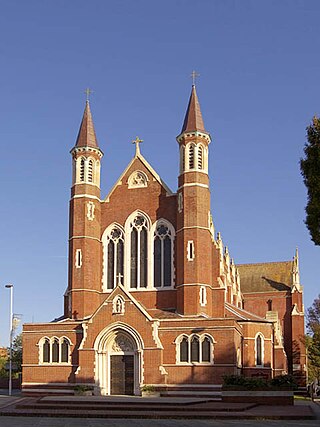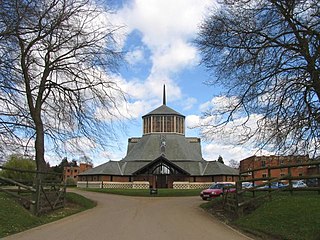History
1615–1818
The monastic community was founded in Paris in 1615 and moved to Douai after the French Revolution taking over the former buildings of the community of St Gregory. The monastery provided educational opportunities from the beginning, but had no formal school in its first decades of existence. A boarding school later emerged in a dependent priory at La Celle.
1818–1903
Following the move to Douai in 1818, and the refoundation of the community by Richard Marsh, a more recognisable school emerged and by 1823, there were 28 boys on the roll. Around that time, the fees for students were being advertised at £32 a year or £30 for church students. [1] Links with the Roman Catholic dioceses in England were crucial to the school's survival. In the 1880s the Roman Catholic Archdiocese of Birmingham was sending seven boys a year to the school. [2] Rather than the vertical house system of English schools, Douai retained the horizontal divisions of 'Rhetoric', 'Poetry', 'Grammar' and 'Syntax' throughout the nineteenth century, and even for a time in its new home in England. [3]
1903–1999
The modern school in Woolhampton, Berkshire was formed by the site's pre-existing St Mary's College's merging with the school of the incoming Benedictine community that moved from Douai in June 1903 as a result of Waldeck-Rousseau's Law of Associations (1901). Former pupils lobbied the Irish Parliamentary Party to raise the matter of the expulsion in Parliament. However it was Roman Catholic English Conservatives who espoused the cause: Lord Edmund Talbot in the House of Commons and 11th Lord Herries of Terregles in the House of Lords. [4]
The merger produced a school of 109 boy boarders, which had fallen to only 63 by 1911. Its long history in France and its monastic influence meant that Douai, although an independent boarding school, had in large part escaped the influence of the public school ethos that had developed in 19th-century England. However, in 1920, Douai was admitted to membership of the Headmasters' Conference. In the 1930s David Matthew, later Apostolic Delegate for Africa, congratulated the headmaster, Ignatius Rice, on the fact that: "no Catholic school has been so free from the influence of Arnold of Rugby as Douai has been." [5]
Day boys were admitted from the early 1960s, when annual boarding fees were £360. [6] By 1984, there was a record number of 333 pupils. The school became co-educational in 1993.
post closure
In November 2017 a former House Master at Douai, Father Michael Creagh, was sentenced at Reading Crown Court after pleading guilty [7] to two counts of child abuse offences which were committed while he was at the Boarding School.
Buildings
In 1786 the Earl of Fingall, the squire of Woolhampton sold his Woolhampton estate and moved to Ireland. His family had been recusant Roman Catholics and had maintained a chapel and chaplain at Woolhampton House (now Elstree School). On leaving the neighbourhood he left his chaplain to minister to the local Roman Catholics and endowed him with some 7 acres (28,000 m2) of lands and some cottages. Three of these cottages stood on the site of the entrance tower, and in one of these, Woolhampton Lodge, the priest lived and had a chapel.
The oldest part of the current buildings date from around 1830. The main entrance and tower were constructed in 1888 in the Tudor Gothic style; the architect was Frederick Walters. In 1829 Fr Stephen Dambrine was appointed to Woolhampton. He embarked on a building programme which included a chapel in the Gothic style opened in 1833 to replace the chapel in Woolhampton Lodge, and which itself was replaced by the present St Mary's in 1848.
The cricket pavilion was built in 1922 to honour the 56 Old Boys of both Douai and St Mary's College who were killed in the First World War.
In the early years at Woolhampton, the school was seen as an appendage to the monastery and it was only with the foundation of a separate abbey church in the 1930s and the creation of distinct school and monastic refectories in 1944 that a degree of separation emerged. The Monastery was greatly expanded in the 1960s with the building of the new monastery designed by Sir Frederick Gibberd.
Haydock Hall, the study hall, was briefly converted into a film set for the shooting of the dormitory scenes in the 1990 film Three Men and a Little Lady . [9] [10] The former school buildings were also used as a location for the 2002 television film of Goodbye, Mr. Chips . [11]
After the closure of the School, the site was developed by Bewley Homes. The theatre block, swimming pool, science laboratories and Ditcham house were demolished, and were replaced by new housing. The main school buildings were redeveloped as private housing.
The gatehouse, hall and three blocks of buildings are grade II* listed. [12] [13]
In July 2017, a clubhouse for Old Boys and a museum was opened on the site of the former cricket pavilion. [14]

The Benedictines, officially the Order of Saint Benedict, are a mainly contemplative monastic religious order of the Catholic Church for men and for women who follow the Rule of Saint Benedict. The male religious are also sometimes called the Black Monks, in reference to the colour of their religious habits, in contrast to other Benedictine orders such as the Olivetans, who wear white. They were founded in 529 by Benedict of Nursia, a 6th-century Italian monk who laid the foundations of Benedictine monasticism through the formulation of his Rule. Benedict's sister, Scholastica, possibly his twin, also became a religious from an early age, but chose to live as a hermit. They retained a close relationship until her death.

The Diocese of Clifton is a Latin Church diocese of the Catholic Church centred at the Cathedral Church of Saints Peter and Paul in Clifton, England.

Charles Walmesley, OSB was the Roman Catholic Titular Bishop of Rama and Vicar Apostolic of the Western District of England. He was known, especially in Ireland, for predicting the downfall of Protestantism in 1821–5 and the triumphant emergence of the Catholic Church.
The Pontifical Liturgical Institute in Rome, located at Sant'Anselmo on the Aventine Hill, promotes the study of the Sacred Liturgy. It is entrusted to the Benedictine Confederation, and has the role of training professors of liturgy and liturgical experts to advance the study and teaching of the Church's liturgy in the various parts of the world.

Downside Abbey is a Benedictine monastery in England and the senior community of the English Benedictine Congregation. Until 2019, the community had close links with Downside School, for the education of children aged eleven to eighteen. Both the abbey and the school are at Stratton-on-the-Fosse, between Westfield and Shepton Mallet in Somerset, South West England. In 2020, the monastic community announced that it would move away from the present monastery and seek a new place to live. In October 2021, the monastic community further announced that as part of their transition they would move in Spring of 2022 to the temporary accommodation of "Southgate House, in the grounds of Buckfast Abbey, Devon, where we will live as the Community of St Gregory the Great". As of 2020, the monastic community of Downside Abbey was home to fifteen monks.

Joseph Leycester Lyne, known by his religious name as Father Ignatius of Jesus, was an Anglican Benedictine monk. He commenced a movement to reintroduce monasticism into the Church of England.
Downside School is a co-educational Catholic independent boarding and day school in the English public school tradition for pupils aged 11 to 18. It is located between Bath, Frome, Wells and Bruton, and is attached to Downside Abbey.

Glenstal Abbey is a Catholic Benedictine monastery of the Congregation of the Annunciation located in Murroe, County Limerick, Ireland. It is dedicated to Saint Joseph and Saint Columba. As of 2018, the abbot of the monastery was Brendan Coffey.

Subiaco Abbey is an American Benedictine monastery located in the Arkansas River valley of Logan County, Arkansas, part of the Swiss-American Congregation of Benedictine monasteries. It is home to thirty-nine Benedictine monks. The abbey and the preparatory school it operates, Subiaco Academy, are major features of the town of Subiaco, Arkansas. It is named after the original Subiaco, Italy, where the first monastery founded by Saint Benedict was located.

St. Anselm's Abbey is a Benedictine Abbey located at 4501 South Dakota Avenue, N.E., in Washington, D.C. It operates the boys' middle and high school St. Anselm's Abbey School, which was ranked by the Washington Post as the most challenging in Washington, D.C., and as the most challenging private high school in the U.S.

Saint John's Abbey is a Benedictine monastery in Collegeville Township, Minnesota, United States, affiliated with the American-Cassinese Congregation. The abbey was established following the arrival in the area of monks from Saint Vincent Archabbey in Pennsylvania in 1856. Saint John's is one of the largest Benedictine abbeys in the Western Hemisphere, with 110 professed monks. The Right Reverend Fr. Doug Mullin, OSB, serves as the eleventh abbot.

The Roman CatholicDiocese of Portsmouth is a Latin diocese of the Catholic Church that covers the Channel Islands as well as parts of England. The episcopal see is St John's Cathedral in Portsmouth and is headed by the Bishop of Portsmouth. The diocese is part of the metropolitan Province of Southwark, which covers all of the far South of England as well as the Channel Islands.

Douai Abbey is a Benedictine Abbey at Upper Woolhampton, near Thatcham, in the English county of Berkshire, situated within the Roman Catholic Diocese of Portsmouth. Monks from the monastery of St. Edmund's, in Douai, France, came to Woolhampton in 1903 when the community left France as a result of anti-clerical legislation. The abbey church is listed Grade II* on the National Heritage List for England.

The Abbey of Saint Mary and Saint Louis is an abbey of the Catholic English Benedictine Congregation (EBC) located in Creve Coeur, in St. Louis County, Missouri in the United States. The Abbey is an important presence in the spiritual life of the Archdiocese of St. Louis. The monks of the Abbey live their faith according to the Benedictine discipline of 'prayer and work', praying the Divine Office five times daily, celebrating daily Masses in English and Latin, and working in the two parishes under their pastoral care and in the Saint Louis Priory School, which the Abbey runs as an apostolate. The Abbey and its school sit on a 150-acre (0.61 km2) campus in west St. Louis County, in the city of Creve Coeur.

Fort Augustus Abbey, properly St. Benedict's Abbey, at Fort Augustus, Inverness-shire, Scotland, was a Benedictine monastery, from late in the nineteenth century to 1998 that also housed a school for boys until 1993.
St. Bede's is a Higher Secondary School in Chennai (Madras), Tamil Nadu, India established in 1907 with the goal of providing Catholic education for children of European and Anglo-Indian descent.
William Ignatius Rice (1883–1955), known in religion as Dom Ignatius Rice, O.S.B., was an English Benedictine monk of Douai Abbey, a headmaster of Douai School (1915–1952), and a first-class cricketer. He was reputedly "the only monk whose cricket performances were reported by Wisden".
The sexual abuse scandal in the English Benedictine Congregation was a significant episode in the series of Catholic sex abuse cases in the United Kingdom. The dates of the events covered here range from the 1960s to the 2010s.
Rt. Rev. George Michael Lenihan OSB was fifth Catholic Bishop of Auckland (1896–1910).

Saint Martin's Abbey is a community of Roman Catholic Benedictine monks who follow the Rule of St Benedict in Lacey, Washington, United States. First founded as a priory in 1895, the abbey is part of the American-Cassinese Benedictine Congregation and the Benedictine Confederation. As of 2020, the monastic community had 20 monks.













